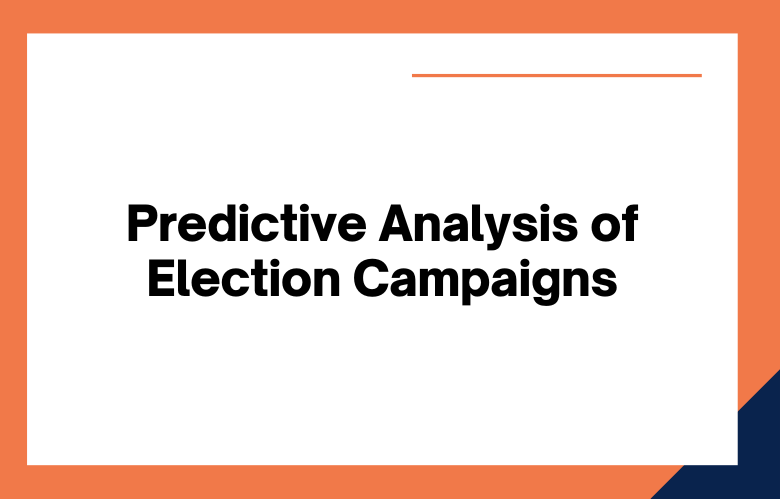In today’s world, data is more crucial than ever before. And when it comes to winning elections, predictive analysis and forecasting are essential. By understanding the past voting patterns of a district or state, campaigns can better determine which areas to focus their efforts on and what messaging will resonate with voters.
By analyzing demographic data, campaigns can better understand the electorate’s composition and adjust their strategy accordingly.
Predictive Analysis and Forecasting for Election Campaigns
Predictive analysis uses statistical techniques to analyze current data and predict future events. Forecasting is a specific type of predictive analysis that uses time-series data (data collected at regular intervals over time) to predict future events.
Both predictive analysis and forecasting can be incredibly useful for election campaigns, as they can help you anticipate voter behavior and make better-informed decisions about campaign strategy.
One popular forecasting method used in election campaigns is trend analysis. It involves looking at historical data to identify patterns to help predict future behavior.
For example, suppose you know a candidate has consistently fared poorly with female voters aged 18-24 in previous elections.
In that case, you might use trend analysis to predict that this will continue to be the case in future elections and adjust your campaign strategy accordingly. Another standard forecasting method is regression analysis, which can identify relationships between variables (such as age, gender, race, etc.) and voting behavior.
The relationships can be used to predict how groups of voters are likely to behave in future elections.
Predictive analysis is a type of data analysis that uses statistical techniques to make predictions about future events. In the context of an election campaign, predictive analysis can forecast everything from voter turnout to which issues are most important to voters.
Forecasting is similar to predictive analysis but focuses on predicting future events based on past trends. For example, if a candidate has strong support from young voters, a forecast might expect that the candidate will also do well with older voters.
Forecasting is often used with predictive analysis to give campaign managers a complete picture of what might happen on Election Day.
Predictive analysis and forecasting are potent tools that can be used to give candidates an edge in the race for the presidency. Using data to identify trends and patterns, campaigns can make informed decisions about where to focus their efforts.
By making predictions about voter behavior, campaigns can tailor their message to appeal to specific groups of voters. Predictive analysis and forecasting are great places to start if you want to boost your candidate in the polls.
Data is the Key to winning elections.
- Predictive analysis and forecasting can help election campaigns in several ways:
- Predictive analysis can identify potential swing voters who could be persuaded to vote for the campaign.
- Forecasting can be used to model different election scenarios and predict the most likely outcome of each design.
- Predictive analysis and forecasting can be used together to develop targeted campaign strategies that maximize the chances of winning an election.
Predictive Analysis
Predictive analysis is a type of data analysis that uses historical data to make predictions about future events. Predictive analysts build models that account for past behavior to predict future outcomes.
This analysis can answer questions like “How many people are likely to vote for my candidate in the next election?” or “What sort of policies do voters care about most?”
Predictive analysis is a method of using past data to make predictions. This method can be used to predict anything, but it is most commonly used to predict future events. To do this, predictive analysts will look at trends in past data and try to identify patterns. They will then use these patterns to predict what will happen.
Forecasting
Forecasting is similar to predictive analysis because it uses historical data to make predictions. However, forecasting is focused more on identifying trends and patterns in data, while predictive analytics is focused on driving specific predictions.
Forecasting can help you answer questions like “What will happen to my candidate’s poll numbers if the economy improves?” or “How will voter turnout affect the election outcome?”
Forecasting is a method of using current data to make predictions. This method can also be used to predict anything, but it is most commonly used to predict future events. To do this, forecasters will look at current data and identify trends. They will then use these trends to predict what will happen.
Uses for predictive analysis and forecasting in election campaigns
Predictive analysis and forecasting can be used in several ways in election campaigns. For example, they can be used to:
- Help identify which voters are most likely to support your candidate
- Determine which issues are most important to voters
- Make predictions about voter turnout
- Estimate the effect of economic changes on voter behavior
- Plan campaign strategy based on past election results
- allocate resources more effectively
- And much more!
The importance of past voting patterns
One of the significant predictors of future behavior is past behavior. And when it comes to elections, this could not be more true. By understanding how voters in a particular district or state have voted in the past, campaigns can better target their efforts.
For example, suppose a campaign knows that a particular district has a voting history for Democratic candidates.
In that case, they can then focus their resources on making sure that Democratic voters in that district are registered and turning out to vote. By understanding past voting patterns, campaigns can anticipate which areas may be more competitive.
For example, suppose a campaign knows that a particular district has a voting history for Republican candidates but has been trending Democratic in recent years. In that case, they may invest more resources in that district to ensure victory.
The importance of demographic data
In addition to past voting patterns, demographic data is another critical factor in election forecasting. By understanding the electorate’s composition, campaigns can better target their efforts.
For example, if a campaign knows that a particular district has many independent voters, it may focus its efforts on courting those voters. Additionally, by analyzing demographic data, movements can adjust their strategy accordingly.
For example, suppose a campaign knows that a particular district has many Hispanic voters. In that case, they may invest in Spanish-language advertising or target Hispanic media outlets.
Conclusion
Data is the Key to winning elections.
By understanding the past voting patterns of a district or state and analyzing demographic data, campaigns can better determine which areas to focus their efforts on and what messaging will resonate with voters.
In today’s day and age, predictive analysis and forecasting are crucial to winning elections. Predictive analysis and forecasting can be powerful tools for election campaigns.
By analyzing data and trends, we can help you decide where to allocate your resources, who to target with your messaging, and how to mobilize your supporters. If you want more information on our services or wish to discuss how predictive analytics could benefit your campaign, please don’t hesitate to contact us.
We would be happy to provide you with our expertise and answer any questions you may have.
Call: +91 9848321284
Email: [email protected]
Frequently Asked Questions (FAQs)
What is predictive analysis in election campaigns?
Predictive analysis uses historical data, machine learning, and statistical modeling to forecast voter behavior, election outcomes, and campaign performance.
How does predictive analysis benefit political campaigns?
It helps in targeting key voter segments, allocating resources efficiently, forecasting turnout, refining messaging, and improving decision-making.
What types of data are used in election predictive models?
Data sources include voter demographics, past election results, social media behavior, polling data, canvassing reports, and survey responses.
What tools are used for predictive analysis in politics?
Tools include Python, R, Tableau, Google BigQuery, Excel, and AI platforms like AWS SageMaker, IBM Watson, and Google Vertex AI.
How accurate is predictive analysis in elections?
Accuracy depends on data quality, model complexity, voter volatility, and real-time updates, but well-trained models can forecast trends with high reliability.
What is voter segmentation in predictive analysis?
Voter segmentation classifies voters into groups based on behavior, preferences, or demographics to tailor messaging and outreach strategies.
How is machine learning applied in election campaigns?
ML algorithms identify patterns in voter data, predict likelihood to vote, sentiment shifts, issue preferences, and optimal timing for contact.
Can predictive analysis forecast voter turnout?
Yes, models can predict likely turnout by analyzing historical participation rates, issue salience, weather patterns, and voter intent signals.
How do campaigns use predictive scoring?
Predictive scoring assigns likelihood scores to voters for behaviors like voting, supporting a candidate, or donating, guiding prioritization.
What is a persuasion model in campaign analytics?
It identifies voters who are persuadable and calculates how likely they are to change their preference based on specific messages or outreach.
What is the role of sentiment analysis in predictive campaigning?
Sentiment analysis assesses voter emotions and attitudes from social media, surveys, or speech to anticipate public reaction and adjust messaging.
Can predictive models account for last-minute political events?
They can adjust for real-time data inputs, but sudden events (e.g., scandals, debates, crises) may disrupt accuracy if not quickly integrated.
How is geospatial data used in election prediction?
It maps voter behavior by location to identify strongholds, swing areas, turnout gaps, and optimize on-the-ground efforts.
Are predictive models used only at the national level?
No, they are used across all levels—national, state, district, and even down to precinct-level microtargeting.
What is the difference between predictive and descriptive analytics in campaigns?
Descriptive analytics explains what has happened; predictive analytics forecasts what is likely to happen using past trends and data models.
Can predictive analytics help with fundraising strategies?
Yes, it can identify high-value donors, predict donation likelihood, and optimize ask amounts and timing for outreach.
What is lookalike modeling in political campaigns?
Lookalike modeling finds new voters who resemble known supporters in behavior or demographics to expand outreach efficiently.
How do campaigns ensure data privacy in predictive modeling?
By anonymizing data, complying with regulations (like GDPR or CCPA), using secure platforms, and maintaining ethical data practices.
How are predictive models validated in political campaigns?
By comparing predictions with actual outcomes, A/B testing messages, using control groups, and measuring against baseline forecasts.
What is the future of predictive analysis in election campaigns?
It involves deeper AI integration, real-time personalization, behavioral psychology insights, and hybrid models combining qualitative and quantitative data.










